All that stood between me and about 500,000 bees were my thin cotton t-shirt, my sweat pants, some gardening gloves and a bee keeper veil. I was acutely aware that there was a hole in the glove, gaps between the ends of my sleeves and the tops of the gloves and my light gray sweat pants were not quite as long as I would have liked. Any trepidation I was feeling was properly squelched as I’m pretty sure my nervousness would have produced some kind of pheromone that the bees could have detected from miles away. I know my girls would have picked up on it and since they were meeting the bees too, I was cool as a cucumber! I was excited to finally get to meet all my niece & nephew bees!
 Laura, “Granbee” and my brother Tom, “Pop-pop” with their first grandchild, Lincoln and one of their three dogs, Chimay.
Laura, “Granbee” and my brother Tom, “Pop-pop” with their first grandchild, Lincoln and one of their three dogs, Chimay.
My sister-in-law Laura has been an animal lover for her whole life. She’s cared for cats, dogs, ferrets, chinchillas, cockatiels, fish, snakes, hamsters, guinea pigs, gerbils, a chipmunk, bunnies, squirrels, raccoons and a very special skunk, named Zulu. So, hundreds of thousands of bees hardly seems a stretch for her! All that and her middle name is “Bee” – seriously! She and my brother, Tom, became interested in beekeeping when they helped with honey extraction at their friend’s farm. They signed up for a beekeeping course, joined their local beekeeper association and are now in their third bee season with 7 humming hives of approximately 350,000 – 700,000 honeybees.
Honeybees as you may know are having a tough time; since about 2006, bee colonies have been in decline. A winter loss study for 2012-2013 shows 45.1% loss of hives across all US Beekeepers. That is a 78.2% loss increase over the previous year. (15% loss is considered normal.) This epidemic is called “Colony Collapse Disorder (CCD).” Researchers are working to determine the cause or causes but mites, pesticides, viral/fungal intruders and the disappearing of foraging habitat are all suspected as contributing to CCD. Honeybees are not native to North America. They were brought by the settlers in about 1622 to provide honey, wax, and to pollinate the native European plants they brought with them (Kellar). Before the honeybees arrived and still today, our native pollinators are bumblebees, stingless bees and flies. The native pollinators do not really make any or much honey and are not plentiful enough (they are also experiencing population declines) to provide all the pollination needed for our large agricultural industry. So we rely on the European honeybee to do much of our pollination and to provide our honey. The health of the bee population is widely recognized as a barometer of the health of the ecosystem at large. The abundance of our nation’s agricultural products are also dependent on the wellness of the honeybee population.
So, why all the “buzz” about the health of these stinging insects? Well, if you’re a food lover, you should really embrace the bees. One third of all our food supply relies on bees for pollination (Holland, 2013). There are just not enough native pollinators available for the job. Honeybees pollinate over a hundred different crops from fruit trees to nuts like almonds to most of your summer farm stand favorites. Bees contribute over $15 billion toward US crop production (Holland, 2013). Without our little fuzzy winged friends, we’d probably lose some crops altogether and see massive increases in the costs of foods as alternative pollination methods would need to be explored. The least we can do is become more informed and try to not squash or spray the bees.
The best way to learn about anything is to jump right in, feet first. So I asked Tom and Laura if they could include me in some of their beekeeping activities. Early spring is a busy time for the hives. The bee population explodes and bees are busy flying out to collect pollen, nectar and water. The beekeepers need to inspect the hives, add boxes where needed, watch for signs of swarming (when a large number of bees fly out to start a new colony with a queen bee) and get honey supers ready (the part of the hive where honey is collected to later extract for human use.) I asked the girls if they’d like to check out the bees with me and they were eager to join the adventure! We were instructed to wear light colored clothing as bees are not aggressive with light colors. So I tucked away all my bright floral muumuu’s (HA!) and opted for a long sleeved white t-shirt and some light gray sweat pants – clearly this was not going to be a fashionable event! I’ll share our visit to Hillendale Apiary below and then I’ll share a yummy cocktail I developed using some Hillendale honey!
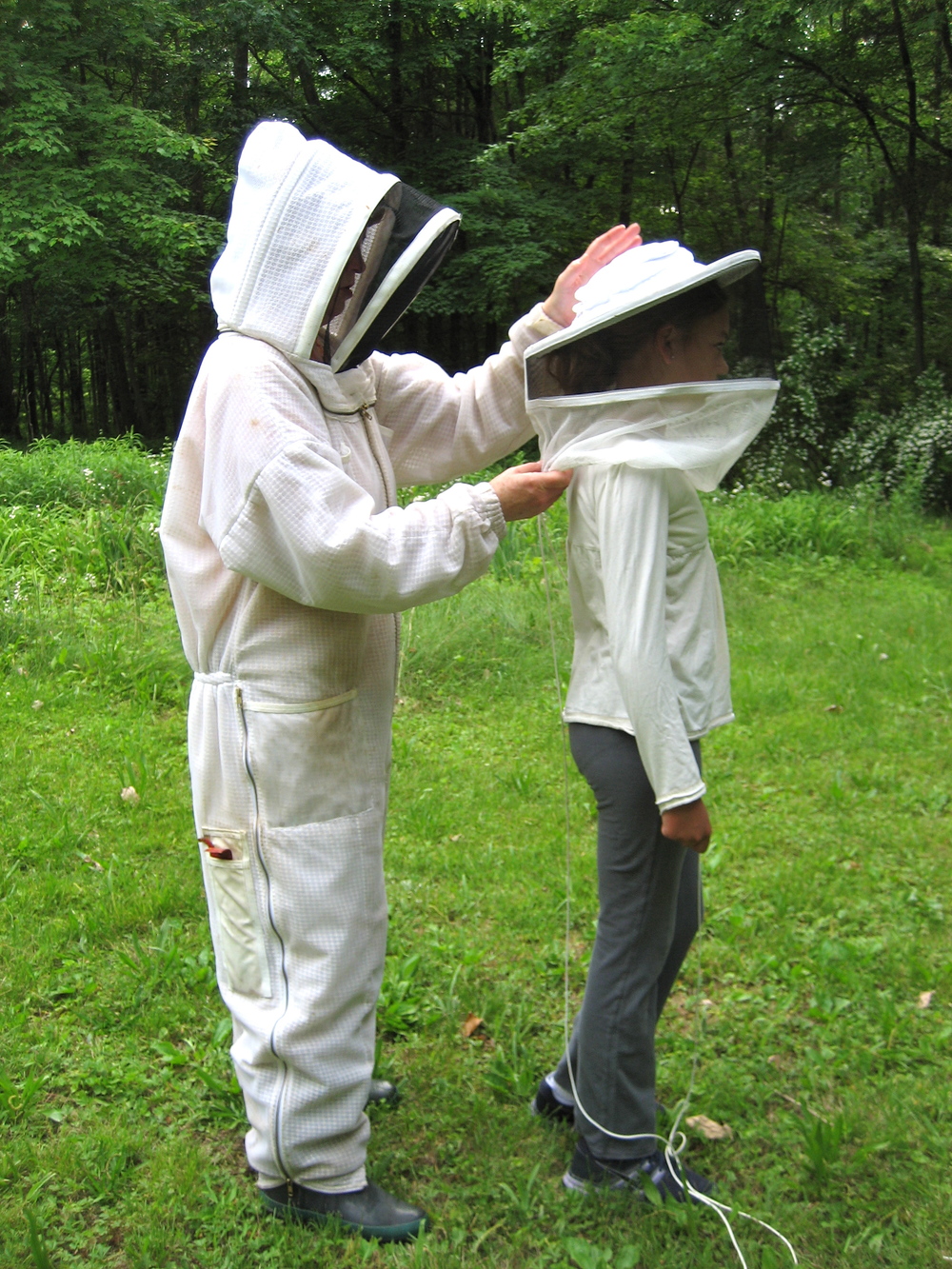 Laura in her beekeeper suit helping Sam to get her veil on.
Laura in her beekeeper suit helping Sam to get her veil on. 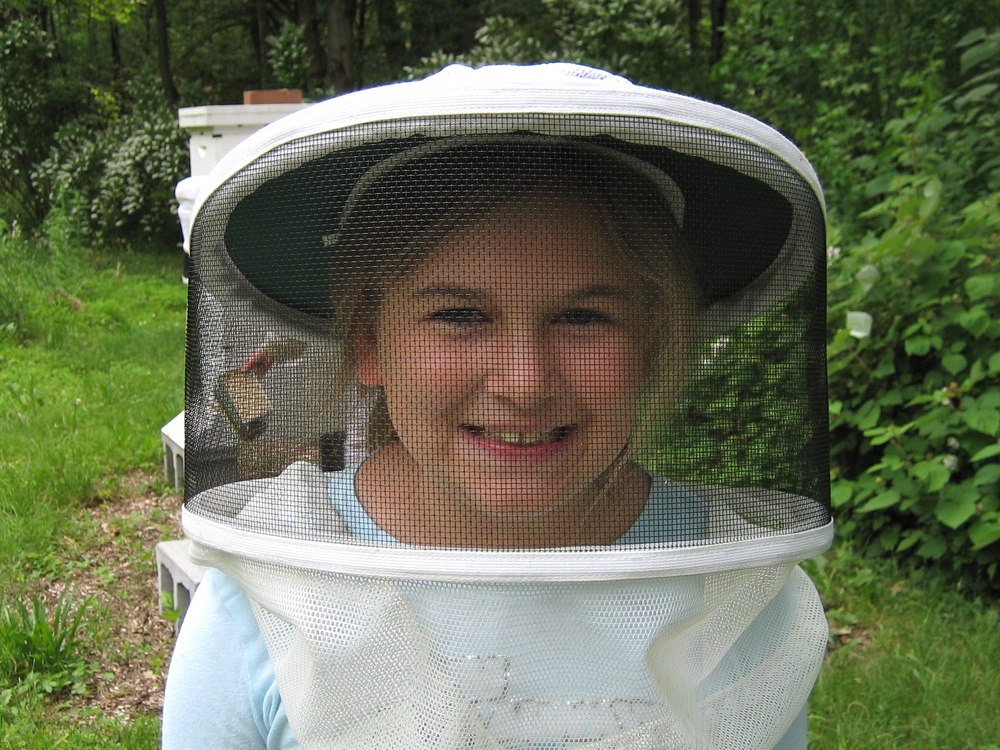 Lauren is ready for the bees!
Lauren is ready for the bees! 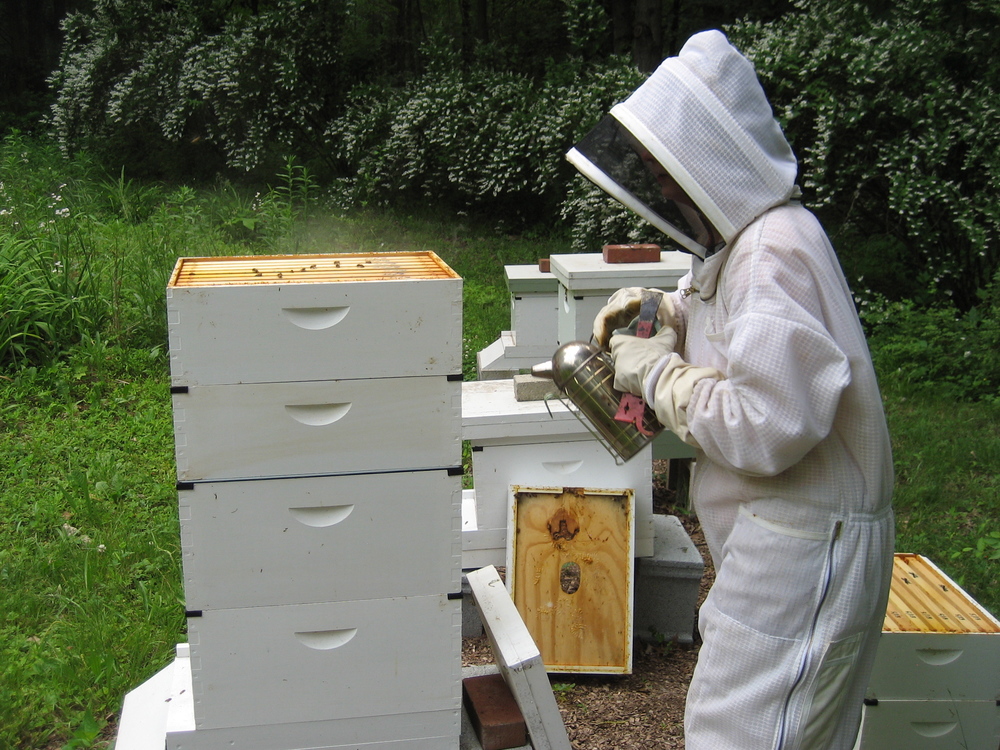 Laura uses a smoker that contains smoldering pine needles to blow smoke into the hive. The smoke calms the bees and they go deeper into the hive.
Laura uses a smoker that contains smoldering pine needles to blow smoke into the hive. The smoke calms the bees and they go deeper into the hive. 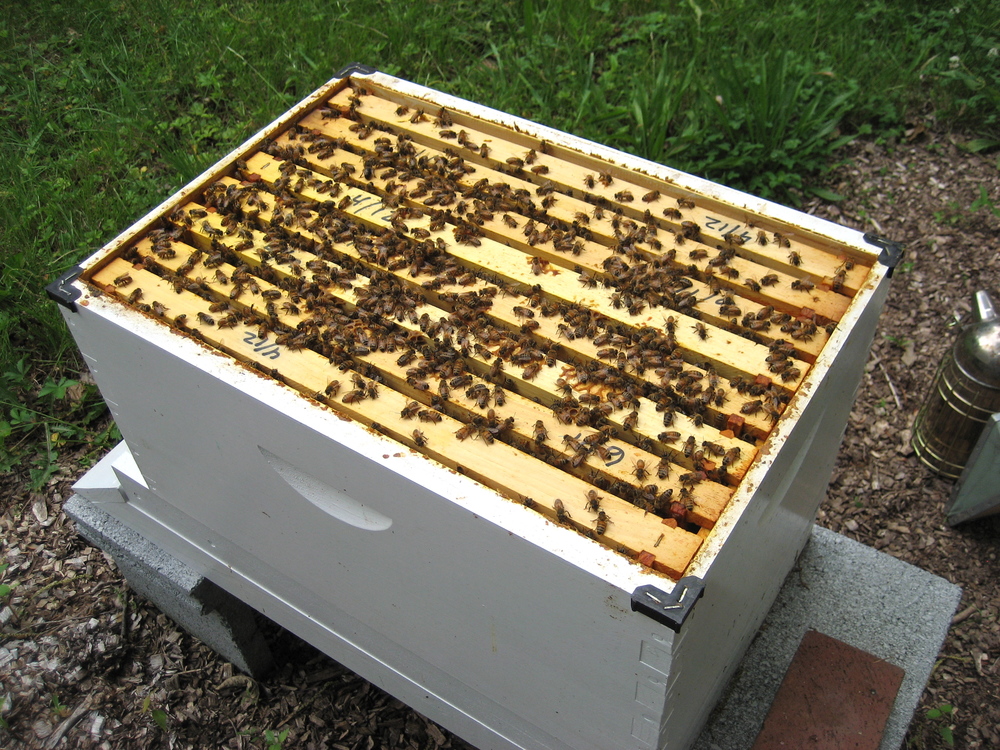 With the top off the hive you can see the frames and the bees.
With the top off the hive you can see the frames and the bees. 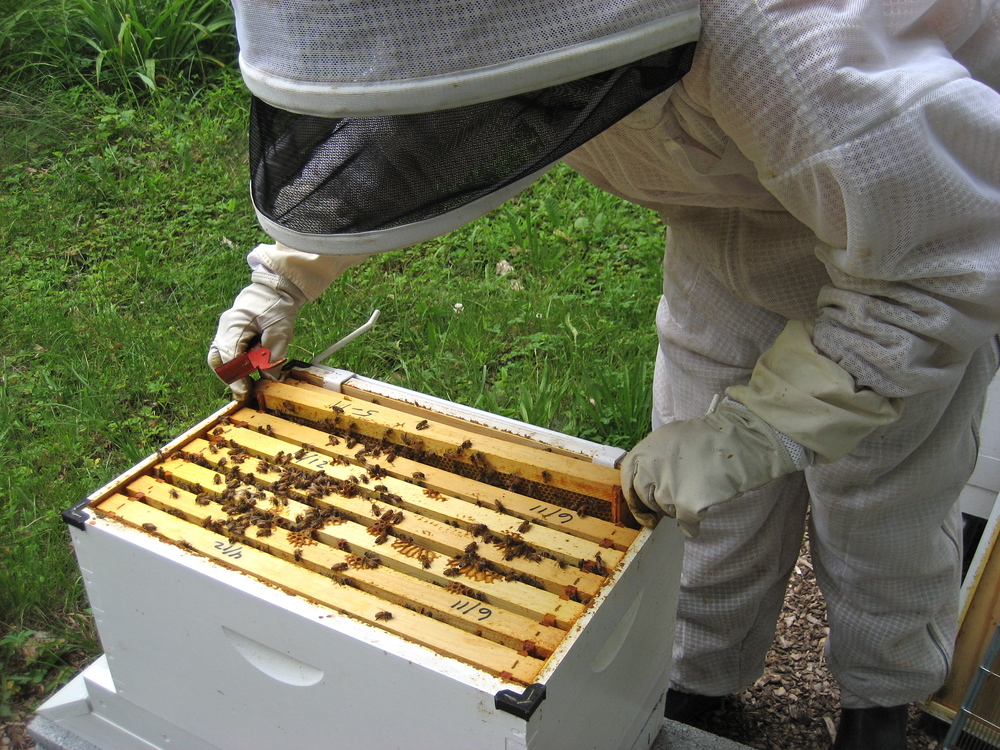 Laura uses her beekeeper tool to loosen the frames from the hive box.
Laura uses her beekeeper tool to loosen the frames from the hive box. 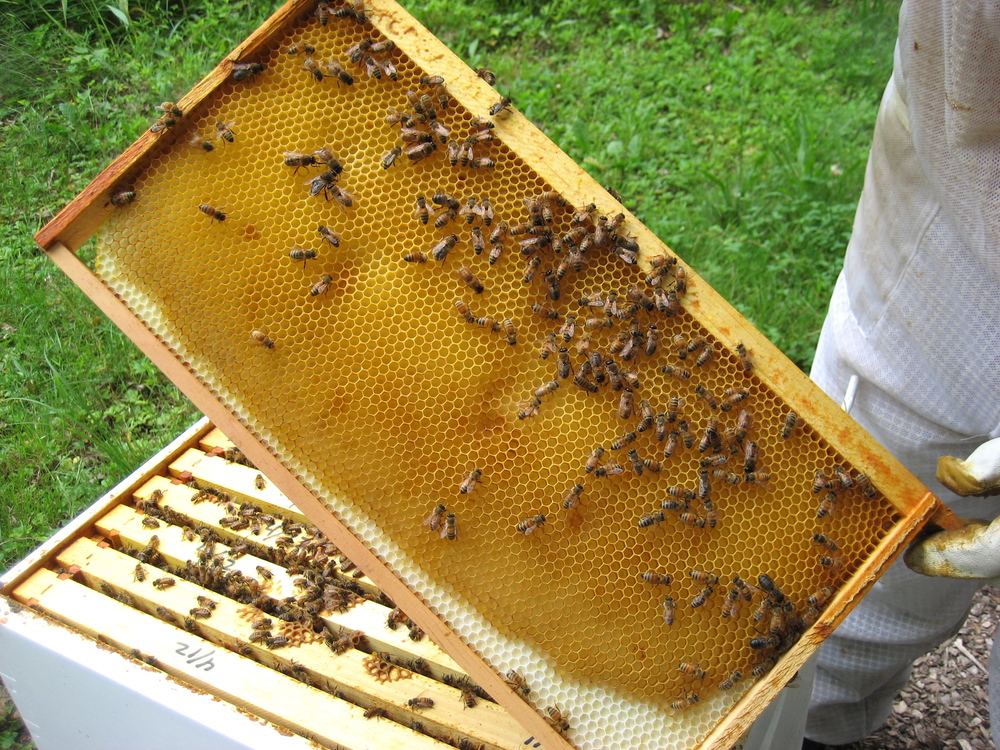 Here is a hive frame, you can see the white plastic foundation that the hives start with and the golden wax that the bees build up from the foundation to form the hexagonal cells.
Here is a hive frame, you can see the white plastic foundation that the hives start with and the golden wax that the bees build up from the foundation to form the hexagonal cells. 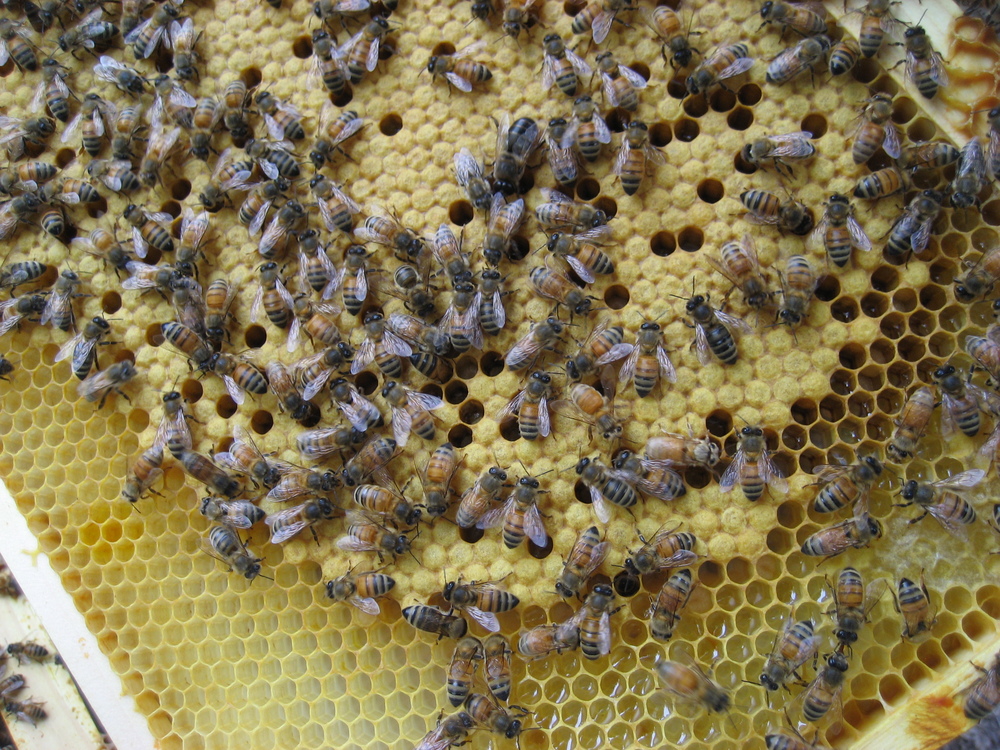 Brood Frame: The golden fuzzy layer covers bee brood. The term “brood” refers to the “baby bees” in the egg, larval and pupal stages of life. The darker cells contain pollen, “bee bread” which is used to feed the brood.
Brood Frame: The golden fuzzy layer covers bee brood. The term “brood” refers to the “baby bees” in the egg, larval and pupal stages of life. The darker cells contain pollen, “bee bread” which is used to feed the brood. 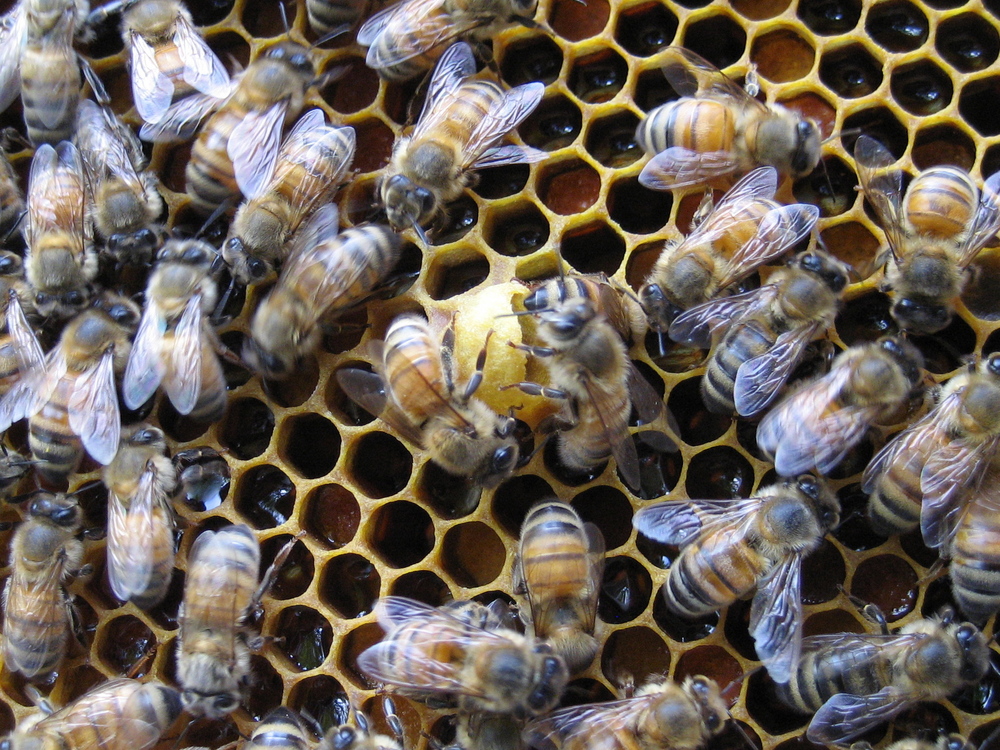 This is a potential new queen cell where a new queen bee could be grown. The darker cells are filled with nectar. The bees in this photo are worker bees who are all female. They work non-stop for the greater good of the hive. They perform various duties such as caring for the brood, building the hive, receiving and processing nectar and foraging for nectar, pollen and water.
This is a potential new queen cell where a new queen bee could be grown. The darker cells are filled with nectar. The bees in this photo are worker bees who are all female. They work non-stop for the greater good of the hive. They perform various duties such as caring for the brood, building the hive, receiving and processing nectar and foraging for nectar, pollen and water. 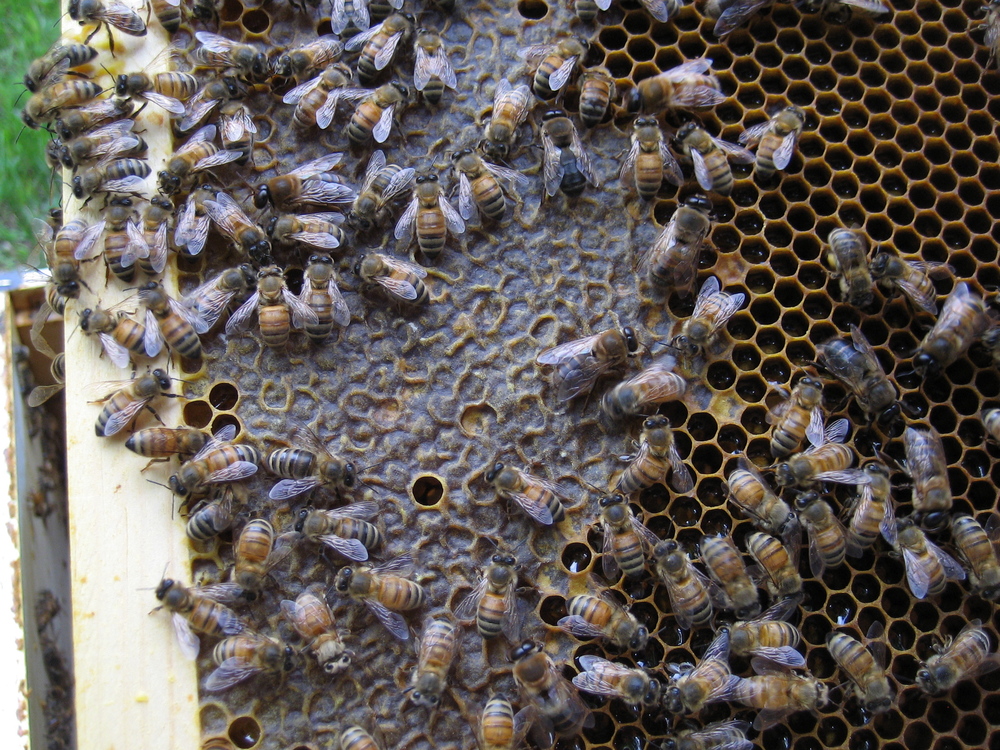 The dark covered cells are filled with old honey.
The dark covered cells are filled with old honey. 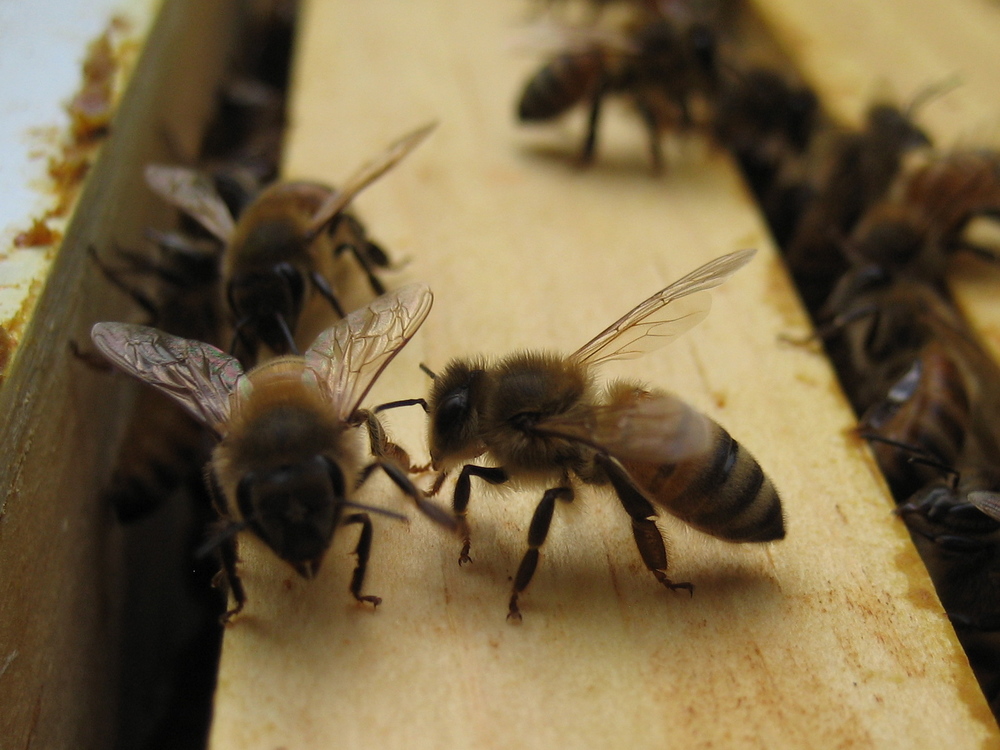 Here is a closeup of some busy worker bees. Notice how fuzzy they are. The hairs help them collect and distribute pollen. While they are deep in a flower gathering nectar, pollen sticks to the hairs. When they go from flower to flower and plant to plant they leave behind some of the pollen from the other flowers – this is pollination!
Here is a closeup of some busy worker bees. Notice how fuzzy they are. The hairs help them collect and distribute pollen. While they are deep in a flower gathering nectar, pollen sticks to the hairs. When they go from flower to flower and plant to plant they leave behind some of the pollen from the other flowers – this is pollination! 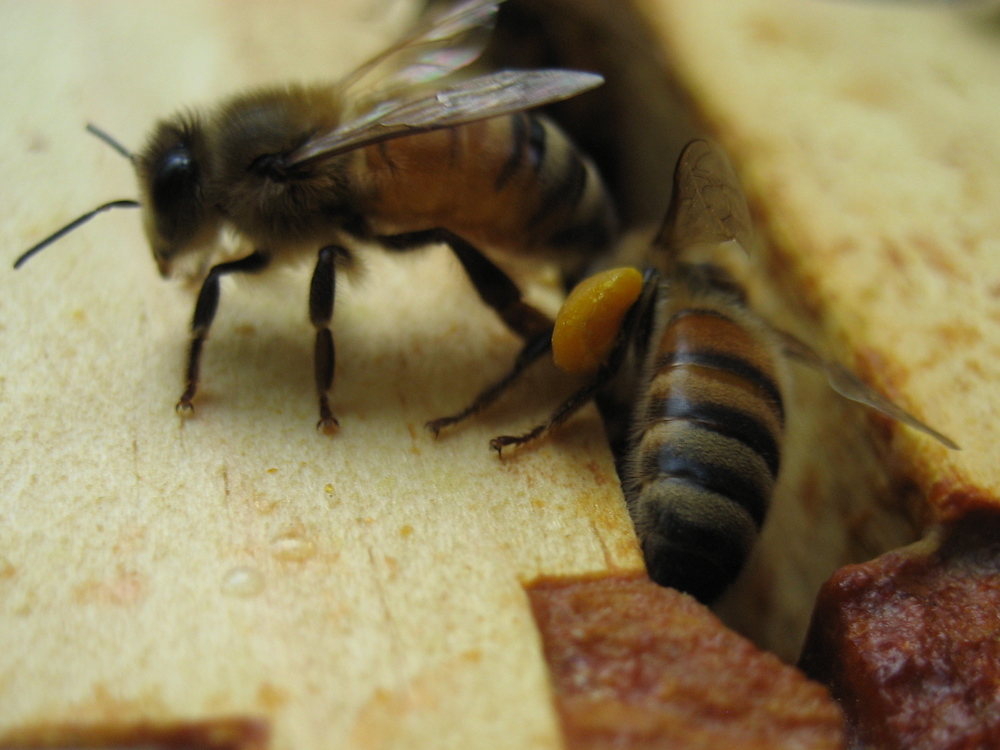 Here you can see gold colored pollen packed into the “pollen basket” on the bee’s leg. This is how the bees carry the pollen they gather back to the hive. Pollen is a protein source for the honeybees.
Here you can see gold colored pollen packed into the “pollen basket” on the bee’s leg. This is how the bees carry the pollen they gather back to the hive. Pollen is a protein source for the honeybees. 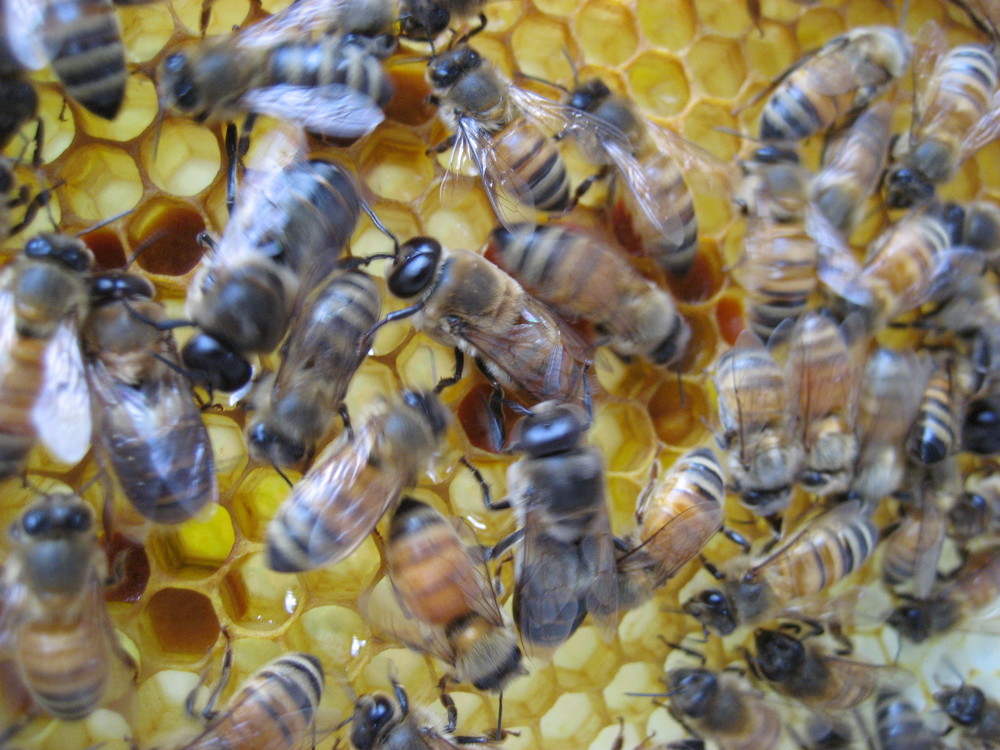 If you look at the eyes of the bees you can detect the female worker bees with their smaller eyes and the male drone bees with their very large eyes. The drone’s role in the hive is to mate with queen bees from other hives. At the end of the season the drones are kicked out of the hive to perish.
If you look at the eyes of the bees you can detect the female worker bees with their smaller eyes and the male drone bees with their very large eyes. The drone’s role in the hive is to mate with queen bees from other hives. At the end of the season the drones are kicked out of the hive to perish. 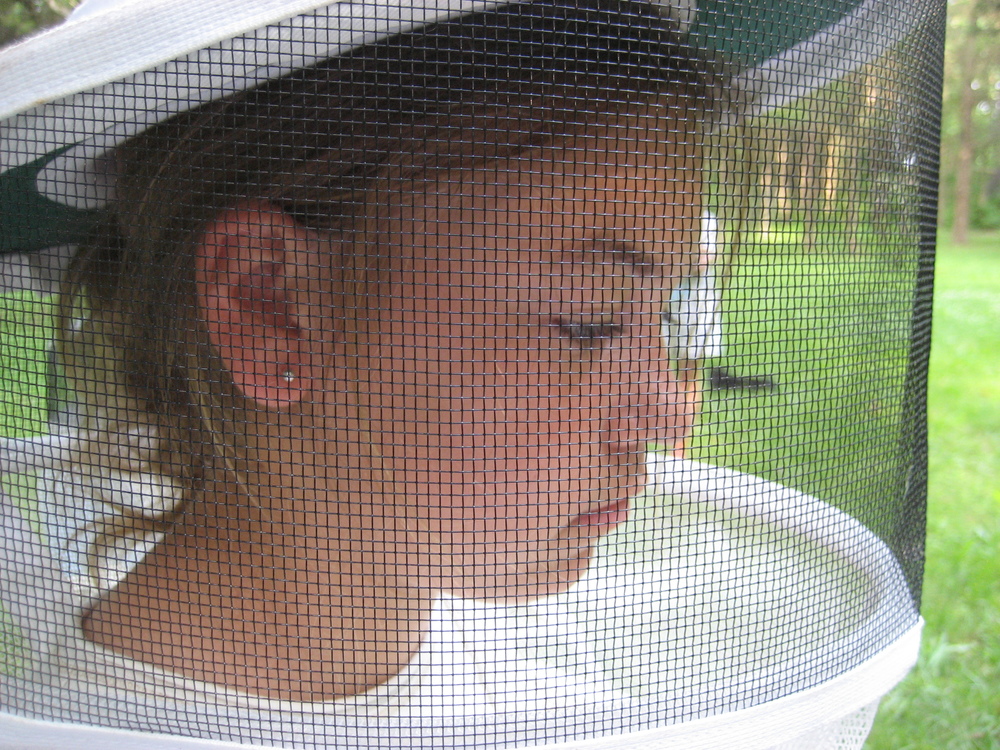 Sam, watching the hive happenings.
Sam, watching the hive happenings. 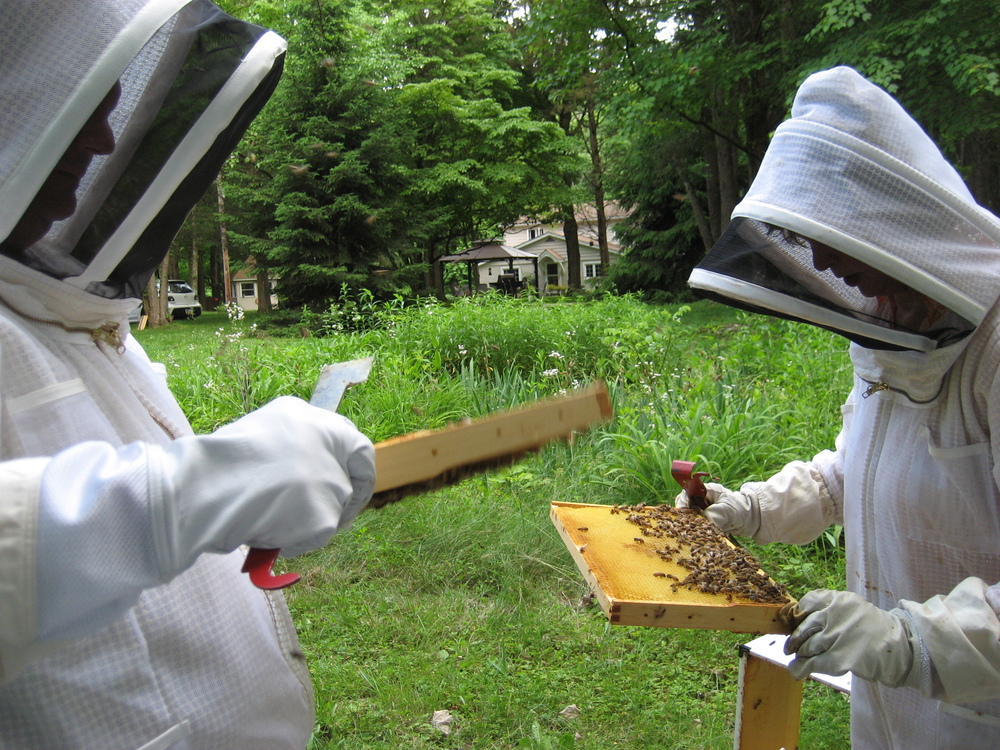 Laura and fellow beekeeper, Dan Boylan search a hive for the queen bee.
Laura and fellow beekeeper, Dan Boylan search a hive for the queen bee. 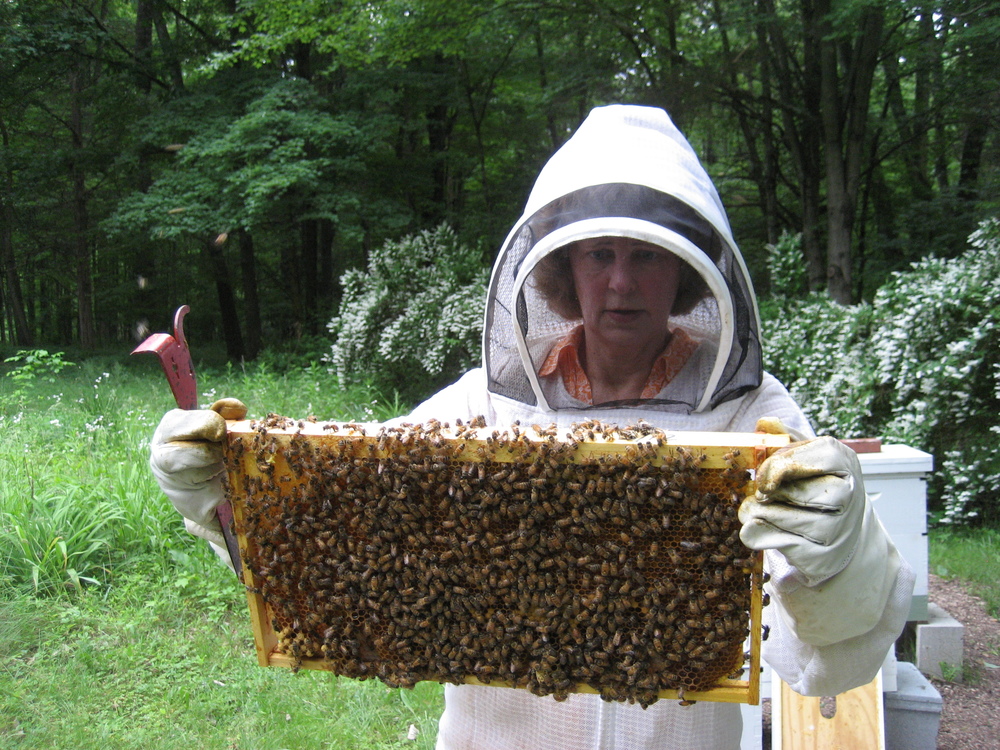 Laura is searching for the queen bee. She has seen new queen cells in this hive. If new queen bees are born there will be more than one queen bee in the hive. When there is more than one queen, the bees will split and “swarm”. This means that a large number of bees will gorge on the hive’s honey supply and swarm with the extra queen to start a new hive. When a hive swarms the hive loses a lot of its honey. Laura decides to split the hive boxes into two new hives in an attempt to thwart a swarm.
Laura is searching for the queen bee. She has seen new queen cells in this hive. If new queen bees are born there will be more than one queen bee in the hive. When there is more than one queen, the bees will split and “swarm”. This means that a large number of bees will gorge on the hive’s honey supply and swarm with the extra queen to start a new hive. When a hive swarms the hive loses a lot of its honey. Laura decides to split the hive boxes into two new hives in an attempt to thwart a swarm. 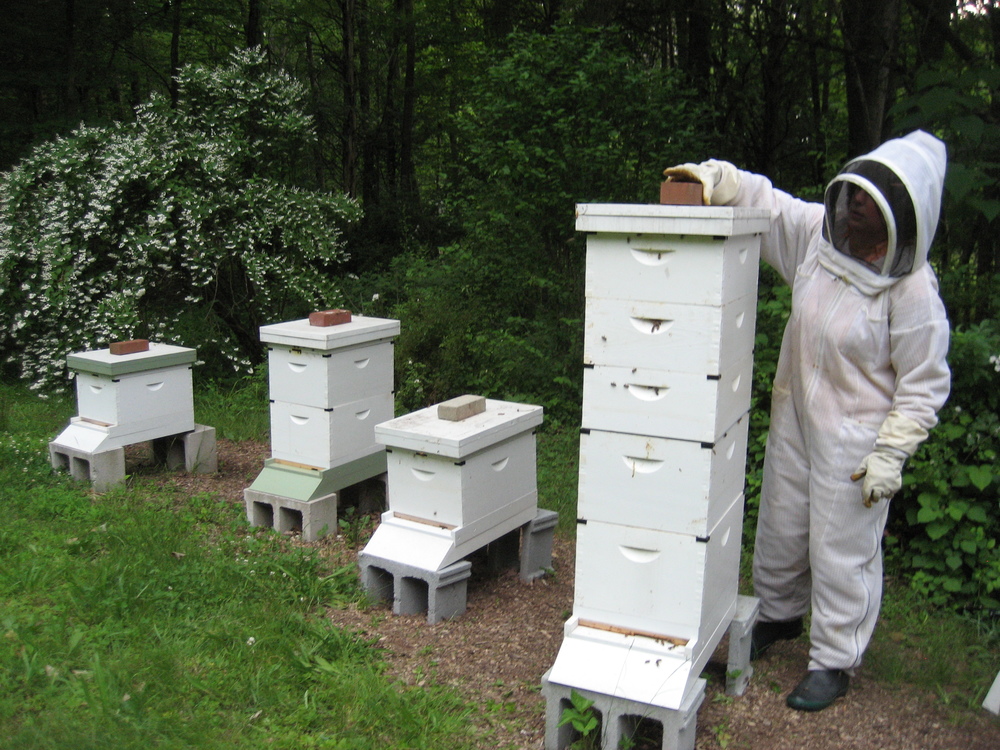 Closing up the hives.
Closing up the hives.
We had such a great time meeting the Hillendale honeybees! We got up close (really close!) with the bees and none of us were stung! A few weeks after our visit, I went with Tom and Laura to their Montgomery County Beekeepers Association meeting in Skippack, PA. There was a talk about cooking with honey along with demonstrations and tastings! Yum! I’ll be posting about that soon! Also, I hope to visit Hillendale again when it’s time to extract some honey! I can’t wait to see how honey extraction works! Stay tuned!
Next up is a honey recipe! The day of our visit was super hot and the heat was compounded by all the gear we had on. I thought a nice ice-cold cocktail would be a refreshing treat after all the hot work in the hive! So this recipe is dedicated to all the hard-working honeybees and the beekeepers who love them!! Cheers!
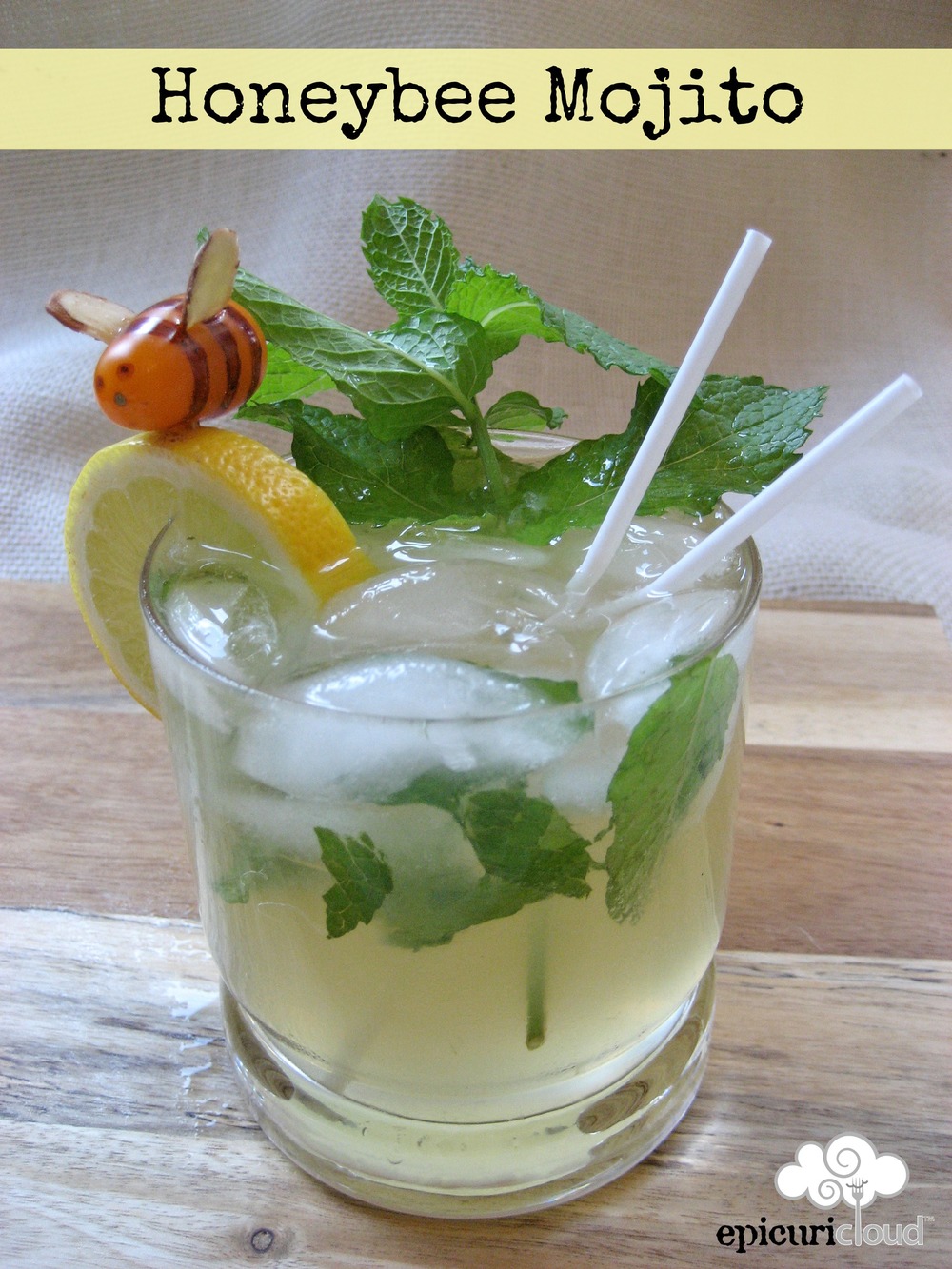
Honeybee Mojito:
Combine lemon juice and honey. Muddle in some mint leaves. Add rum and top with ice and club soda!
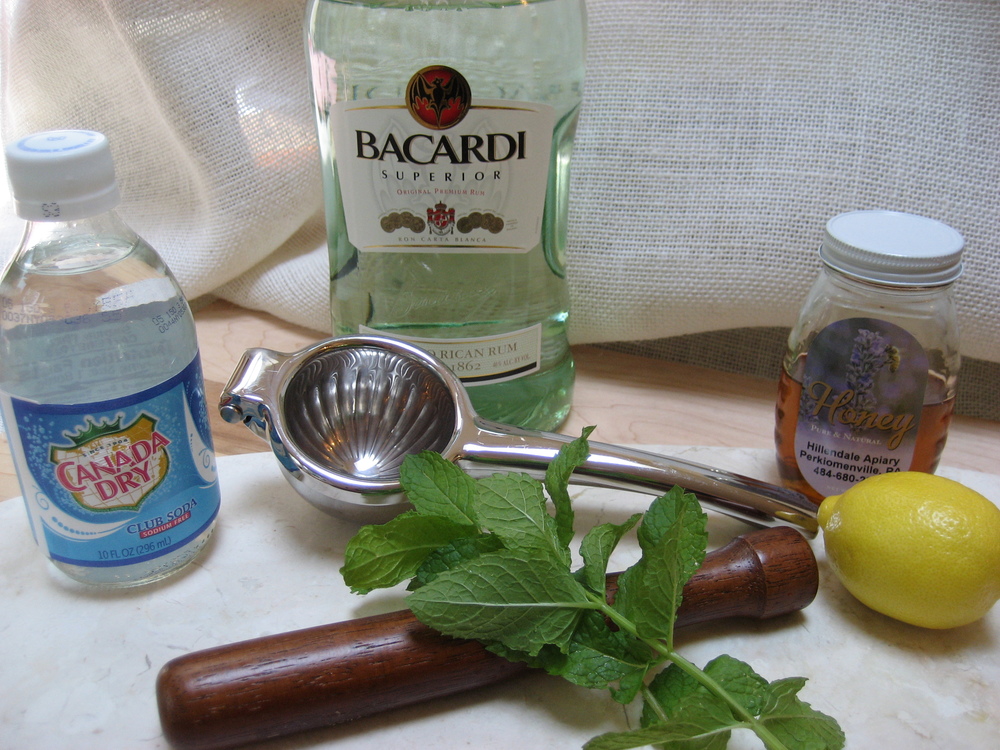
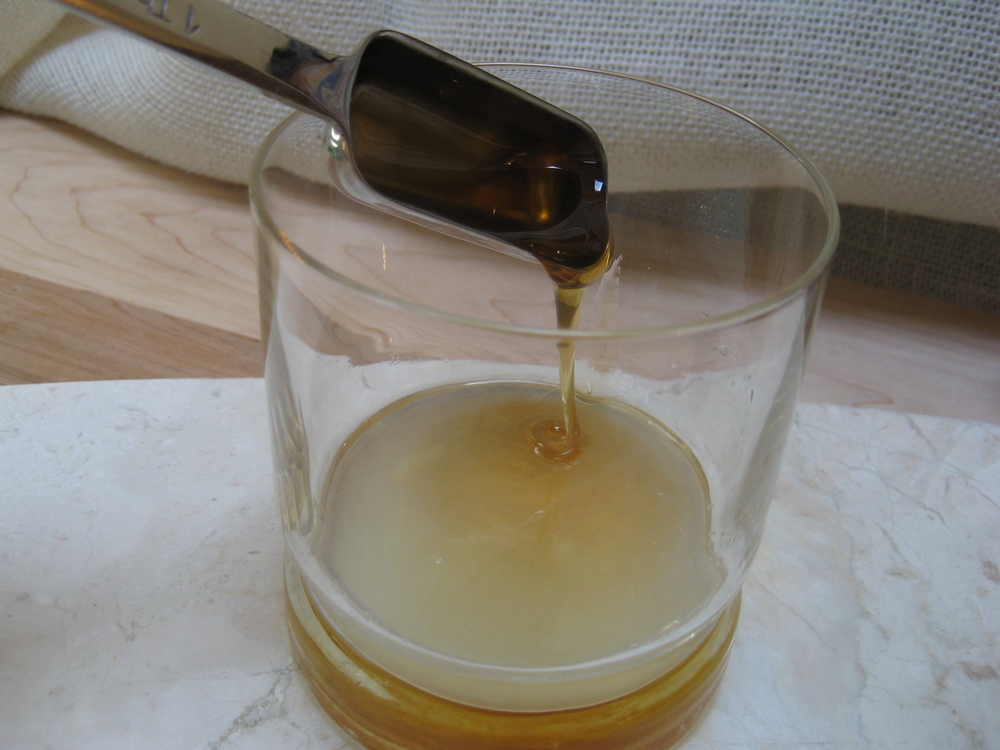
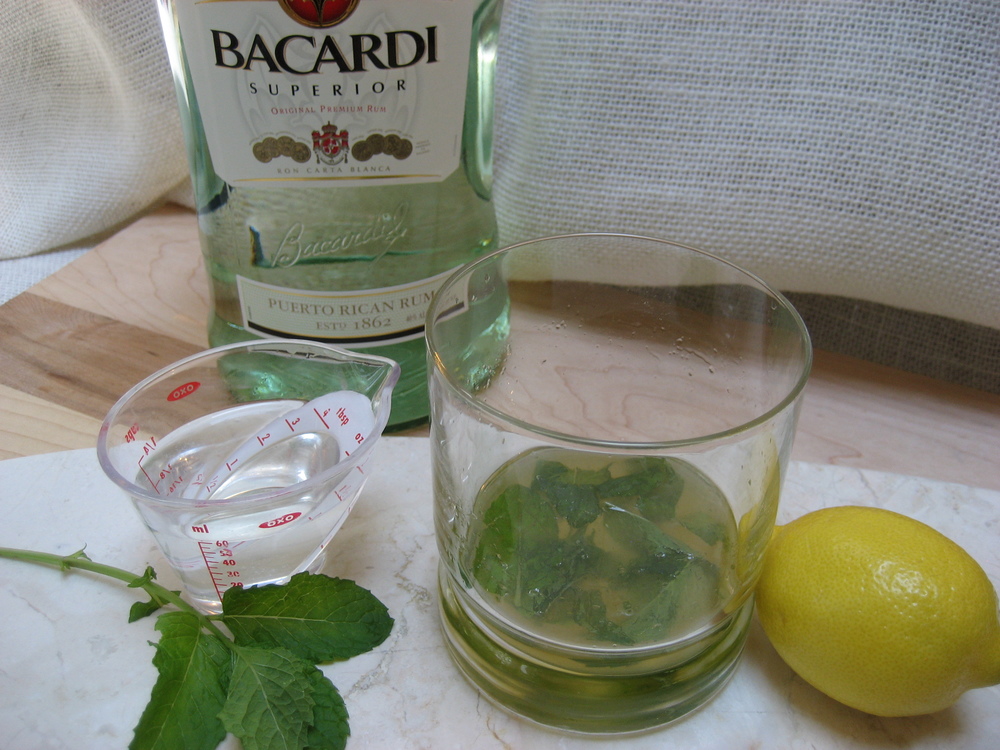
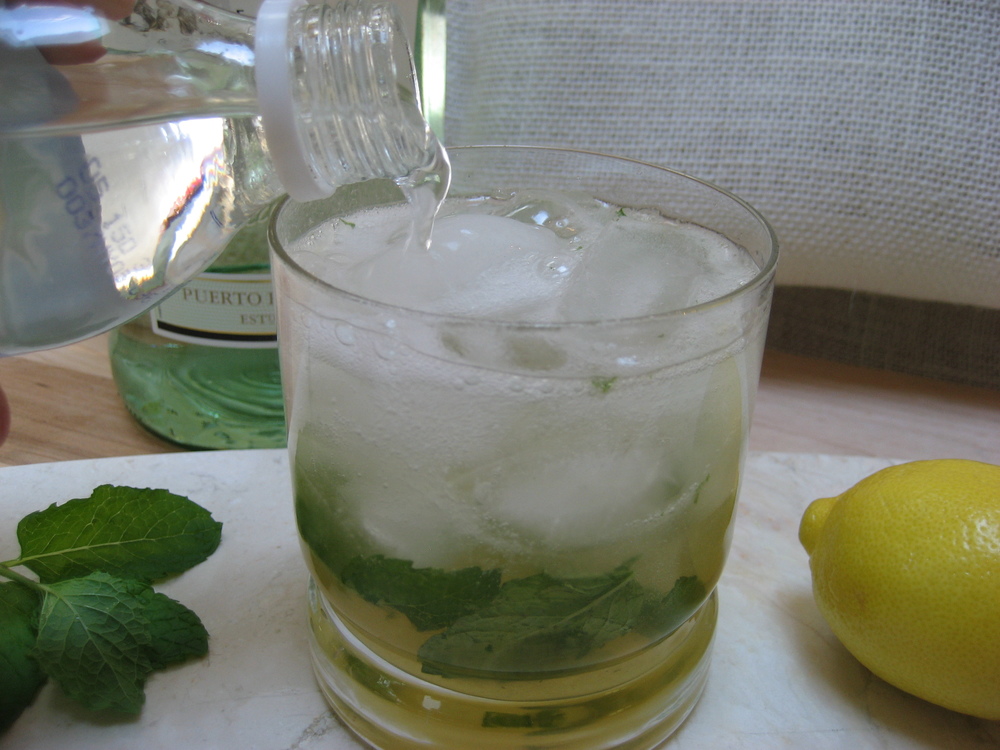
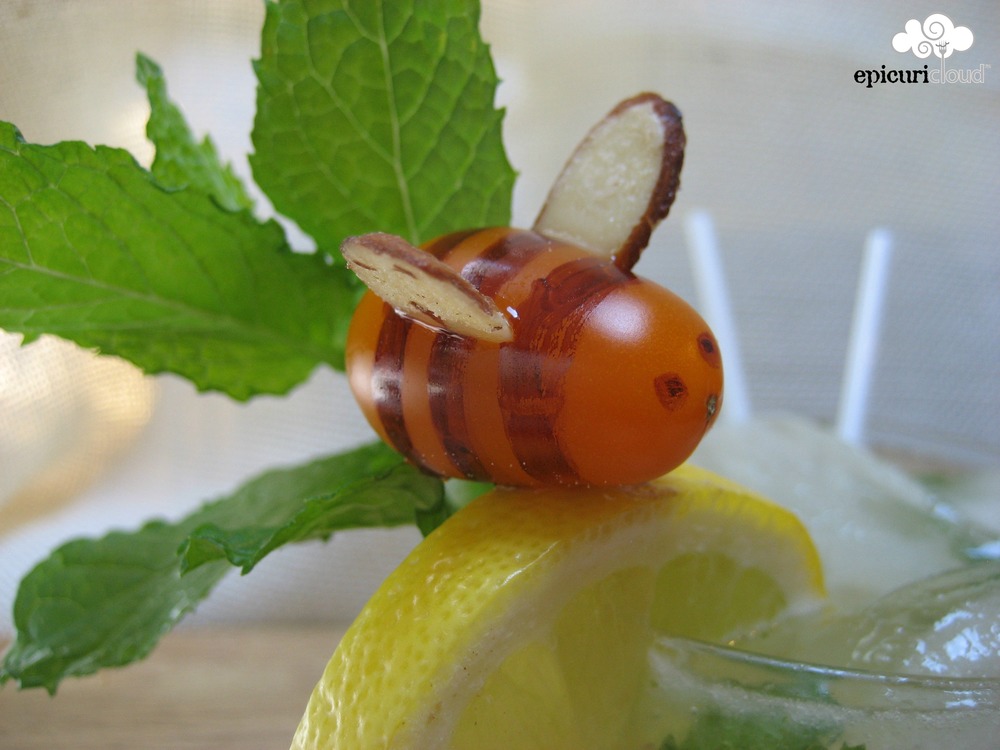
A big buzzy thank you to Tom & Laura!! We really enjoyed meeting the Hillendale bees and learning about beekeeping!
Thank you for spending some time in the cloud with me! I hope you enjoy the recipe! Stay tuned for more bee adventures!
Tina ( :
Honeybee Mojito:
Ingredients
- 2 tablespoons lemon juice
- 1 tablespoon + 1 teaspoon teaspoon honey
- 6 large mint leaves
- 2 ounces light rum I used Bacardi Superior White Rum
- 1/2 cup club soda
- ice
Optional Garnish:
- yellow grape or pear tomatoes
- sliced almonds
- food coloring marker or sharpie (will make garnish not edible)
Instructions
- In a 12-ounce glass stir together lemon juice and honey.
- Add mint leaves and use a muddler or the blunt end of other kitchen tool to stir and muddle (crush) mint leaves.
- Stir in rum, add some ice, club soda and stir.
- Garnish with a lemon slice and some mint leaves if desired.
- Cheers to the honeybees!
Optional Garnish:
- If you want to make a honeybee garnish, use a small yellow or golden grape or pear shaped tomato.
- Draw on the stripes with a Sharpie or food coloring marker. (The Sharpie marker would make the garnish non edible.)
- Use a sharp knife to make a little slit where you will insert sliced almonds for wings.

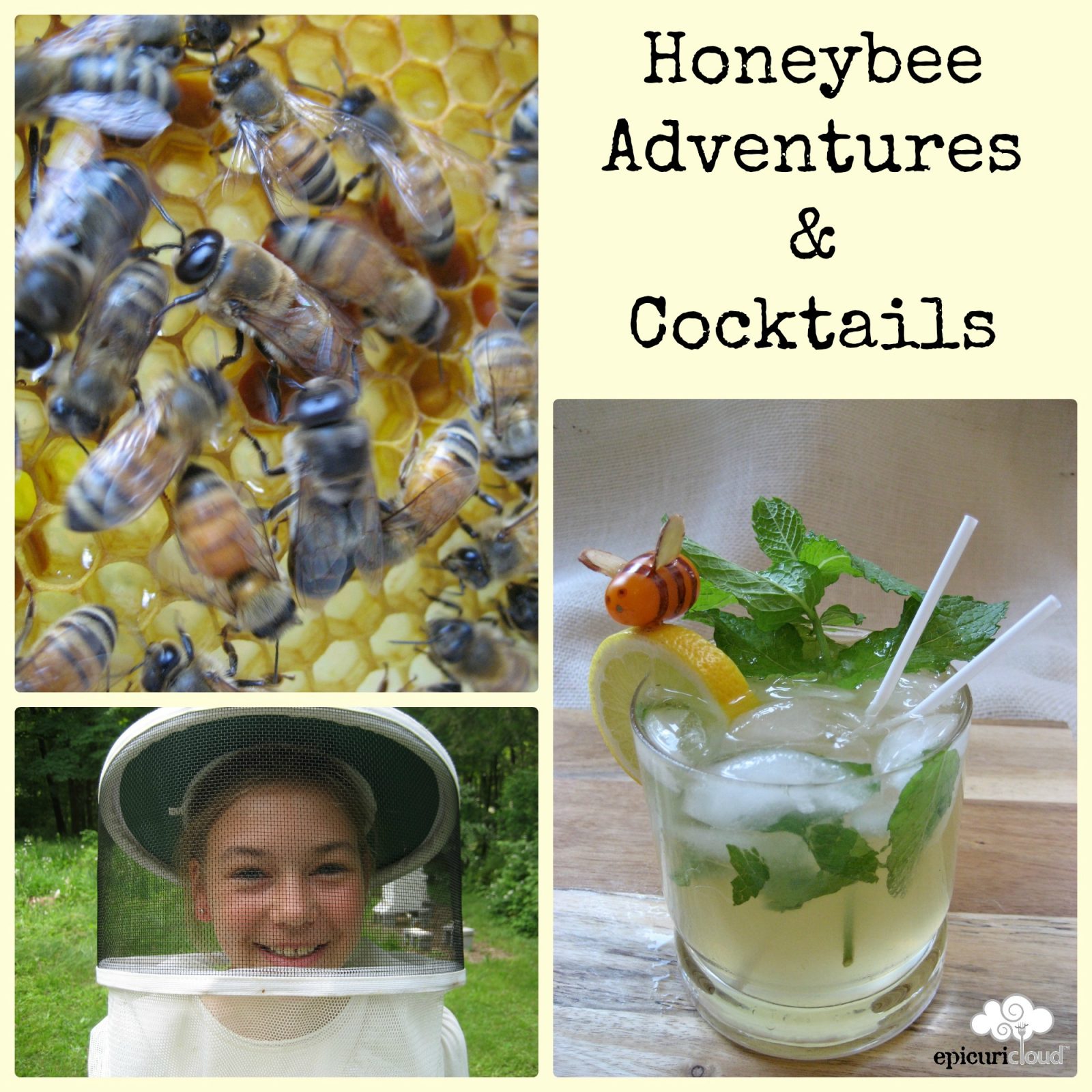
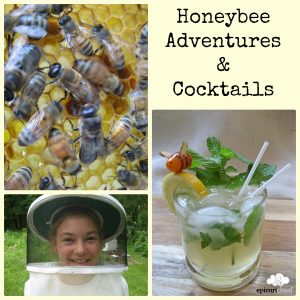
Dear mom,

I LOVE your blog-it is so interesting to read! You are 115% awesome! Love U!!!!!!
Love, Samantha.
Thanks Sam!! I think you are 125% awesome!! Love U 2!!!
Those close-up pictures of the bees are amazing! And I’m impressed that your girls got up close. I’m also impressed that your kids read your blog. Mine won’t. I think they believe it will suck their soul and capture all their personal information.
You always crack me up Nancy!! She actually hasn’t read it in quite a while, but was determined to post a comment this time – maybe because her photo was featured!! ( :
Great post, Tina! I loved reading about your adventures and seeing the pictures. I have a meyer lemon tree right outside my back door, and I am actually happy when I see lots of honeybees surrounding it, knowing what you detailed above. I actually did a post about bees WAY back when my blog was still new (and my photos really embarrassing!): http://peanutbutterandjulie.com/2008/05/spiced-honey-be.html — and you just reminded me of this! Love your garnish for the cocktail–cute!
Just read your post – thought is was wonderful!! Seems like things have not changed much for the bees since you posted in ’08! Let’s hope the bees can start to thrive soon!! Enjoy those meyer lemons!! ( :
Tina, you really are 115% AWESOME!! : )
Love your photos, love the Honeybee Mojito Recipe!! I cant believe how much research and hard work you do for your blog. Thank you!!!
I really learned a lot about Bees!! Looking forward to a few more posts about them & honey recipes too!!
Very cool! Love the cocktail too.
Thanks Lisa!! Have a great day!! ( : Tina
Love this post…I swore I comment on it before but I guess it didn’t go through! Your bee pictures are awesome. I invited you to my Cocktail Concoctions group board on Pinterest and I will pin your Honeybee Mojito there! Thanks!
Thanks Kristin!! Cocktail Pin Board!! Yum!!
We need many initiatives to save the bees, as they are very important for the ecosystem.
Yes! agreed!